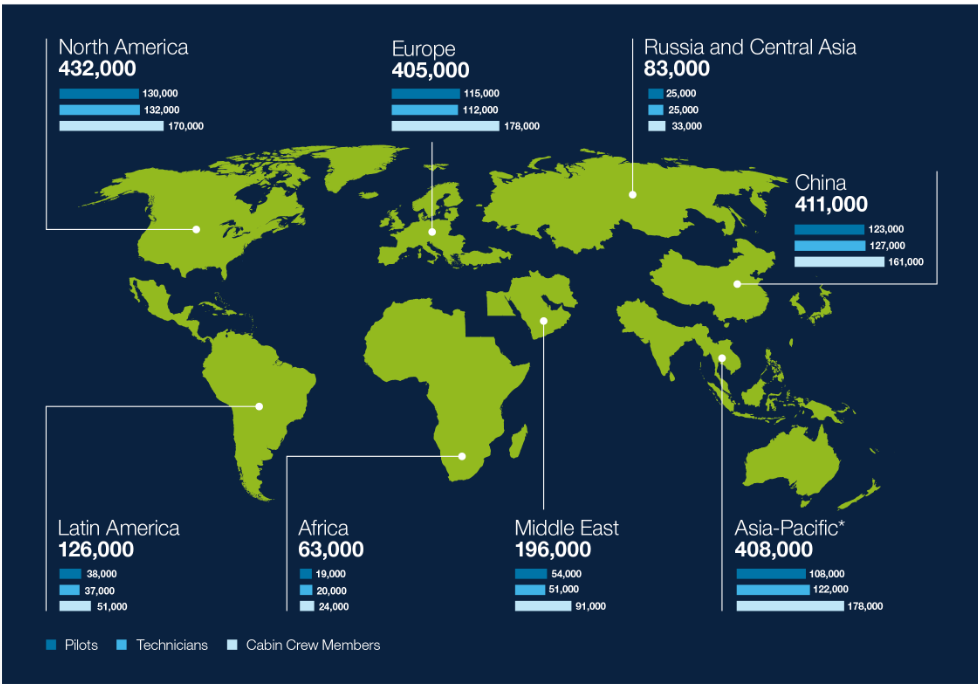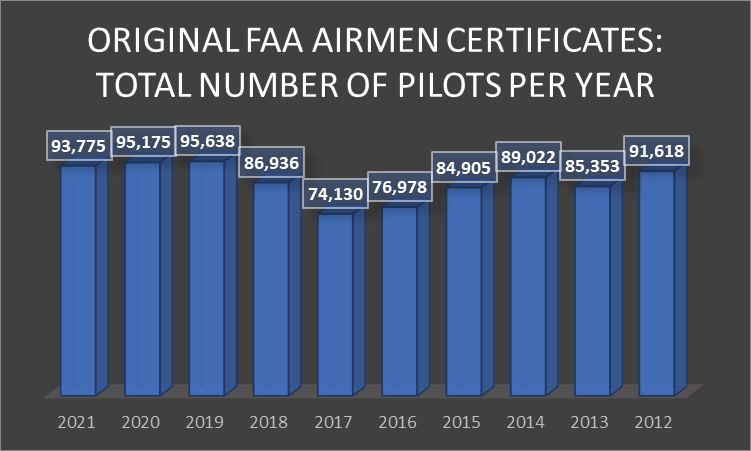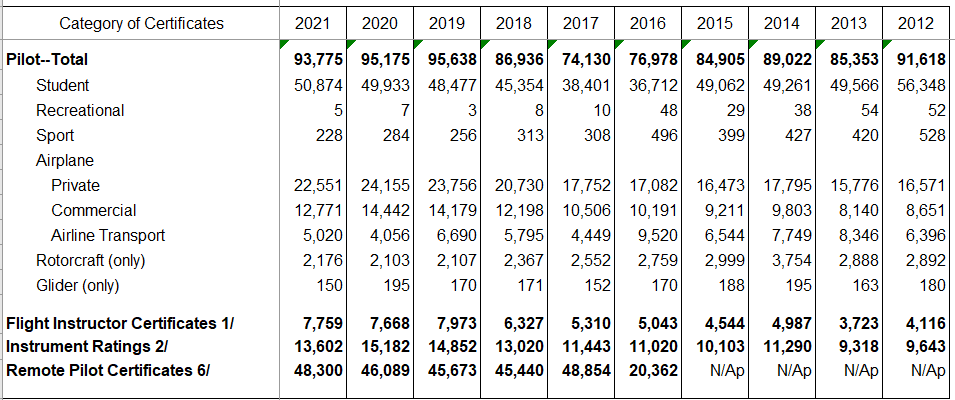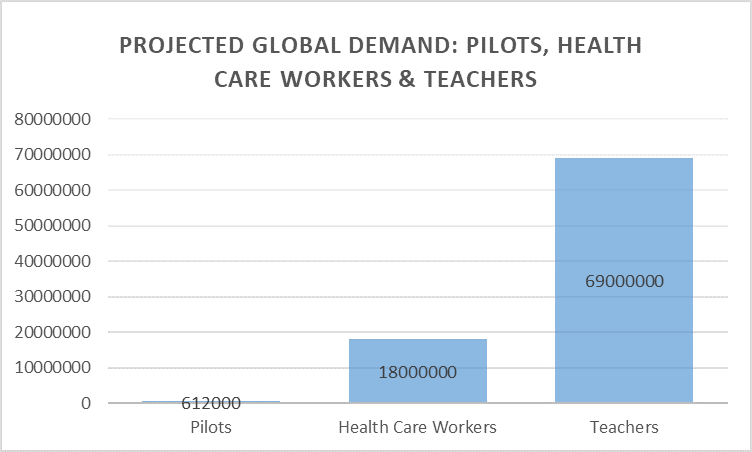What Pilot Shortage???
Some sectors of the aviation industry allege that there is a pilot shortage, claims that are all too often used to justify dousing communities across this country with noise, lead emissions and other toxic pollutants. On the other hand, a fact sheet, Pilot Supply by the Numbers, released by the Air Line Pilot Association International (ALPA), the largest airline pilot union in the world, states:
"Regardless of what the airlines are saying, there is no pilot shortage and there are more than enough certificated pilots to meet demand here in the United States. The aviation industry is currently producing more pilots capable of immediately stepping into the right seat than there are jobs available to them.
However, there is a need to hold airlines accountable for the $63 billion in taxpayer subsidies they received during the pandemic, money that was designed to maintain their workforce and prepare for the economic recovery we are experiencing today… Airlines are looking for ways to boost revenue and many are looking to shed labor costs in any way possible..."
"The average number of ATPs [Airline Transport Certificate licenses] issued per year since 2012 is 6,500. Growth is expected, yet even if that number stays the same, that equates to a surplus of 4,000 pilots annually."
A recent BBC report, The New Airlines Betting Flying is About to Take Off, on the launch of a new European airline, also confirms a surplus of pilots. As noted in the article, "The Norwegian firm received more than 3,000 applications for its first 50 pilot jobs." According to an aviation expert mentioned in the article, "since 2020, new airlines could also easily attract out of work cabin crew and pilots - many of whom lost their jobs during the pandemic."
Then there is this 5/31/2022 CBS report suggesting that the Biden Administration, which has yet to issue an endangerment finding on leaded aviation fuel, has aligned with those who maintain that 14,500 pilots will be needed each year for the next decade.
Boeing also maintains there is a pilot shortage. An analysis of their numbers appears below.
Boeing Pilot Shortage Projections 2021-2040
According to Boeing's projections, there is a worldwide need for 612,000 new pilots over a 20-year timeframe ending in 2040. The following map is from the Boeing: Pilot and Technician Outlook 2021-2040 report. The dark blue line at the top of each global section represents estimated pilot need per region.

The bar graph below provides a breakdown of estimated demand by global region.

This section provides averages of how many pilots would need to be trained per global region and individual country to address Boeing's estimated pilot shortfall. The U.S. flight training industry has had a devastating impact on many local communities as a result of unilateral decision-making by the FAA and the aviation industry, who without community input or consent, hone deals with foreign countries to train their pilots. If each global region assumed responsibility for training enough pilots to meet their estimated demand, the relentless noise, toxic pollution, and financial cost currently borne by U.S. residents could be significantly reduced.
It is vital that foreign countries understand that the FAA is a captive agency which does not consult with local communities before degrading the environment and eroding livability. To the contrary, it aligns with profiteers from the flight training industry whose interest in padding their pockets far exceeds their concern for the health and well-being of local residents. As a result, many U.S. residents are now seeking humanitarian relief from the enormous amount of noise, lead poisoning and other toxic pollutants dumped on innocent children, pregnant mothers, and vulnerable adults throughout this country.
Though the averages provided in this release are based on a per country basis, it is fully understood that some countries within a global region may have the resources to provide pilot training while others may not. Arrangements to negotiate these variations can take place within the specific region.
North America
The estimated need for pilots in North America, which according to the Boeing map appears to include primarily the United States and Canada, is 130,000. This number represents approximately 21.2 percent of the total global need. To reach this quota over the 2021 to 2040 year timeframe, these two countries combined would need to train 6,500 pilots per year. Since the population of the U.S. is approximately 9 times greater than that of Canada, the U.S. portion would come to 5,850 pilots annually. Distributed among 50 states this translates into training 117 pilots per state, per year.
Table 1 of the FAA Civil Airmen Statistics for 2021 indicates that the U.S. has already met their pilot demand regional quota for years to come. Between 2016 and 2021, more than 250,000 student pilots were certified to train in this country. Table 17 of this same document includes data on the number of pilot certificates issued between 2012 and 2021, a total of 873,530. Even if no other country on the entire planet trained a single pilot, this is more than enough to meet Boeing's worldwide projected demand. Note that in 2020, the year of the pandemic lockdown, 95,638 pilot certificates were issued, the third highest recorded during the 10-year timeframe. Below is a bar graph showing the number of pilots issued FAA pilot certificates between 2012 and 2021.

Of this number, 473,988 were student pilots, a category that accounted for more than half of all pilot certificates in any given year.

The following table is from the 2021 FAA Civil Airmen Statistics website. It shows the number of original airmen certificates issued by category over a 10-year period from 2012 to 2022.
Table 17 (Abridged)
Original Airmen Certificates Issued by Category
Calendar Year 2012-2021

1/ Not included in total.
2/ Special ratings shown on pilot certificates above, not included in the total.
6/ Started in August 2016. Not included in totals. The number includes applications signed by CFI.
N/Ap Not applicable
China
Pilot demand for China (including the special administrative regions of Hong Kong and Macau) is 123,000 (21% of total) which would require training 6,150 pilots per year. Surely China with one of the largest and fastest growing economies in the entire world and the largest military on the planet, can train its own student pilot population.
Europe
The projected demand for pilots in Europe is 115,000 (18.7% of total) which requires training 5,750 pilots per year. According to the Federal Aviation Administration (FAA), there are 50 countries in Europe. Since Boeing included Russia and Central Asia in a separate category, the total number of European countries is 44. To meet the 5,750 annual pilot demand numbers, each European country would need to train 130 pilots per year.
Asia-Pacific
The projected demand for pilots in the Asia-Pacific is 108,000 (18% of total) which requires training 5,400 pilots per year. The FAA lists 40 Asia-Pacific countries. After subtracting out China which is recognized as a separate region on the Boeing map, the total comes to 39. The Asia-Pacific region includes India, Australia, New Zealand, Japan, South Korea, North Korea, Vietnam, Thailand, Cambodia, Laos and 29 other countries. If each of these countries accepted responsibility for training 270 pilots per year they could meet their 5,400 pilot quota.
Middle East
Boeing's projected demand for pilots in the Middle East is 54,000 (8.82% of total) which requires training 2,700 pilots per year. The FAA lists 18 countries in this region including Qatar, Kuwait, United Arab Emirates, and Saudi Arabia, some of the richest countries on the planet. Countries in the Middle East should have more than enough money to easily train 150 pilots per year to meet their annual quota.
Latin America
The Boeing map includes 17 countries in South America and Central America: Argentina, Bolivia, Brazil, Chile, Colombia, Costa Rica, Ecuador, El Salvador, Guatemala, Honduras, Mexico, Nicaragua, Panama, Paraguay, Peru, the Dominican Republic and Uruguay as well as 13 Caribbean countries. The pilot need for this region is 38,000 (6.2% of total), a quota that could be reached by training 1,266 pilots per year, approximately 42 pilots per country.
Russia and Central Asia
Central Asia includes Kazakhstan, Kyrgyzstan, Tajikistan, Uzbekistan, and Turkmenistan as well as Russia. According to Boeing projections, this region will need 25,000 (5% of total) pilots by 2040, a quota that can be met by training 1,250 pilots per year. If each of the 6 countries listed above trained 208 pilots annually, this could be achieved.
Africa
The FAA lists 49 countries in Africa. According to Boeing this global region will need 19,000 (4% of total) pilots by 2040, an average of 950 per year. If each of the 49 countries in this region trained 19 pilots, this quota could be reached.
Other Critical, Societal Needs Far Outweigh the Need for Pilot Training
The following bar chart illustrates that the global need for health care workers and teachers far exceeds the need for pilots.

According to the Biden-Harris Administration Global Health Worker Initiative Fact Sheet, "The COVID-19 pandemic has further exacerbated the estimated global shortage of 18 million health workers by 2030." The need for health workers far exceeds the global need for pilots by a factor of nearly thirty to one. The need for teachers across the globe is also urgent. In the words of a 1/24/2022 Education International report, "Even before the pandemic, the United Nations estimated that 69 million more teachers were needed to…ensure inclusive and equitable education for all." The global need for teachers exceeds the projected demand for pilots by a factor of over one-hundred and twelve to one. An equitable distribution of pilot training across the globe would free up money and resources that could be redirected to addressing the urgent need for health care and educational providers.
Conclusion
The FAA, Boeing and other aviation industry proponents have intentionally distorted the facts in an effort to convince the American people that they are responsible for bearing the cost as well as the noise and pollution burden for training the entire 612,000 pilots needed globally between 2021 and 2040. The actual need for these pilots is in question. A review of the actual numbers reveals that there is no substantiated need for more pilot training or for maintaining a network of 19,919 airports in this country, particularly when the entire European continent, with a population twice that of the U.S., manages to get by with 2,323 airports.
It is way past time to perform a comprehensive cost, environmental and health benefit analysis on every U.S. airport. Questions like "Why does the U.S. have so many airports compared to other countries?", "Who do they serve?" and "At what cost to the American people and the overall health of the planet?" need to be asked. There is substantial data indicating there is a surplus of pilots. In fact, the evidence suggests that current rates of pilot training far exceed the established need. Having an excess of pilots competing for low wage jobs and reduced benefits may serve the airline companies, but it is ultimately a disservice not only the workers but also to the communities across this land who are forced to foot the bill and bear the burden of the noise and pollution generated by the aviation industry.
| © Oregon Aviation Watch | Contact Us |  Jump to Top Jump to Top |
